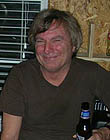|
|
This topic comprises 2 pages: 1 2
|
|
Author
|
Topic: The "Door" on Sound Heads
|
|
|
|
|
|
|
|
|
|
|
|
|
Stephen Furley
Film God

Posts: 3059
From: Coulsdon, Croydon, England
Registered: May 2002
|
 posted 01-12-2005 02:52 PM
posted 01-12-2005 02:52 PM




quote: Thomas Procyk
But the door on the Simplex 5-Star has a clear plexiglass "window" on it. So if its job is to contain fire, it fails, and if its job is to keep light out, it fails.
I don't know what a 5-star sound head is, but if it's got a plexiglass, or similar, window in it then either it's something fairly modern, i.e. post nitrate (ok, it could still be about 50 years old!), or the original glass has been replaced. Given that few soundheads from the nitrate era are still in use today, I would guess that it's a modernised version of an old design, and thick, wired glass was no longer considered necessary.
| IP: Logged
|
|
|
|
|
|
Leo Enticknap
Film God

Posts: 7474
From: Loma Linda, CA
Registered: Jul 2000
|
 posted 01-12-2005 05:15 PM
posted 01-12-2005 05:15 PM





The most widespread fire prevention device on projector operating sides was the combination of an enclosed spool magazine and film cutting device where the film was pulled into or out of it. The cutters were so that if film in the feed spool ignited, the fire wouldn't then spread to the take-up magazine (and vice-versa).
Remember, you cannot prevent or arrest a nitrate fire by removing the oxygen supply (i.e. housing film in an airtight enclosure), because the combustion process generates its own oxygen. So whatever the reason was for enclosing projector mechs and soundheads, it wasn't nitrate fire safety. My guess would be noise suppression and/or keeping dust out. There are some mechanisms, e.g. the GK-19, which have safety magazines but the rest of the mechanism open.
Some earlier spool magazines were airtight (or very nearly so), and if the film within caught fire, the rapidly expanding combustion gases would usually cause them to explode. That's why, from the late '20s onwards, you started to see spool magazines with tapered lips facing away from the operator's side, to allow a film fire to burn itself out in a controlled way and with the smoke and flames directed away from the projectionist. Of course if this did happen you wouldn't want to stay around - one or two deep breaths of those nitric acid fumes and your lungs would be like you'd smoked 80 a day all your life - but it did buy you the time needed to get safely clear.
| IP: Logged
|
|
|
|
|
|
|
|
|
|
|
|
|
|
All times are Central (GMT -6:00)
|
This topic comprises 2 pages: 1 2
|
Powered by Infopop Corporation
UBB.classicTM
6.3.1.2
The Film-Tech Forums are designed for various members related to the cinema industry to express their opinions, viewpoints and testimonials on various products, services and events based upon speculation, personal knowledge and factual information through use, therefore all views represented here allow no liability upon the publishers of this web site and the owners of said views assume no liability for any ill will resulting from these postings. The posts made here are for educational as well as entertainment purposes and as such anyone viewing this portion of the website must accept these views as statements of the author of that opinion
and agrees to release the authors from any and all liability.
|

 Home
Home
 Products
Products
 Store
Store
 Forum
Forum
 Warehouse
Warehouse
 Contact Us
Contact Us




 Printer-friendly view of this topic
Printer-friendly view of this topic










![[uhoh]](graemlins/uhoh.gif)

![[Eek!]](eek.gif)








